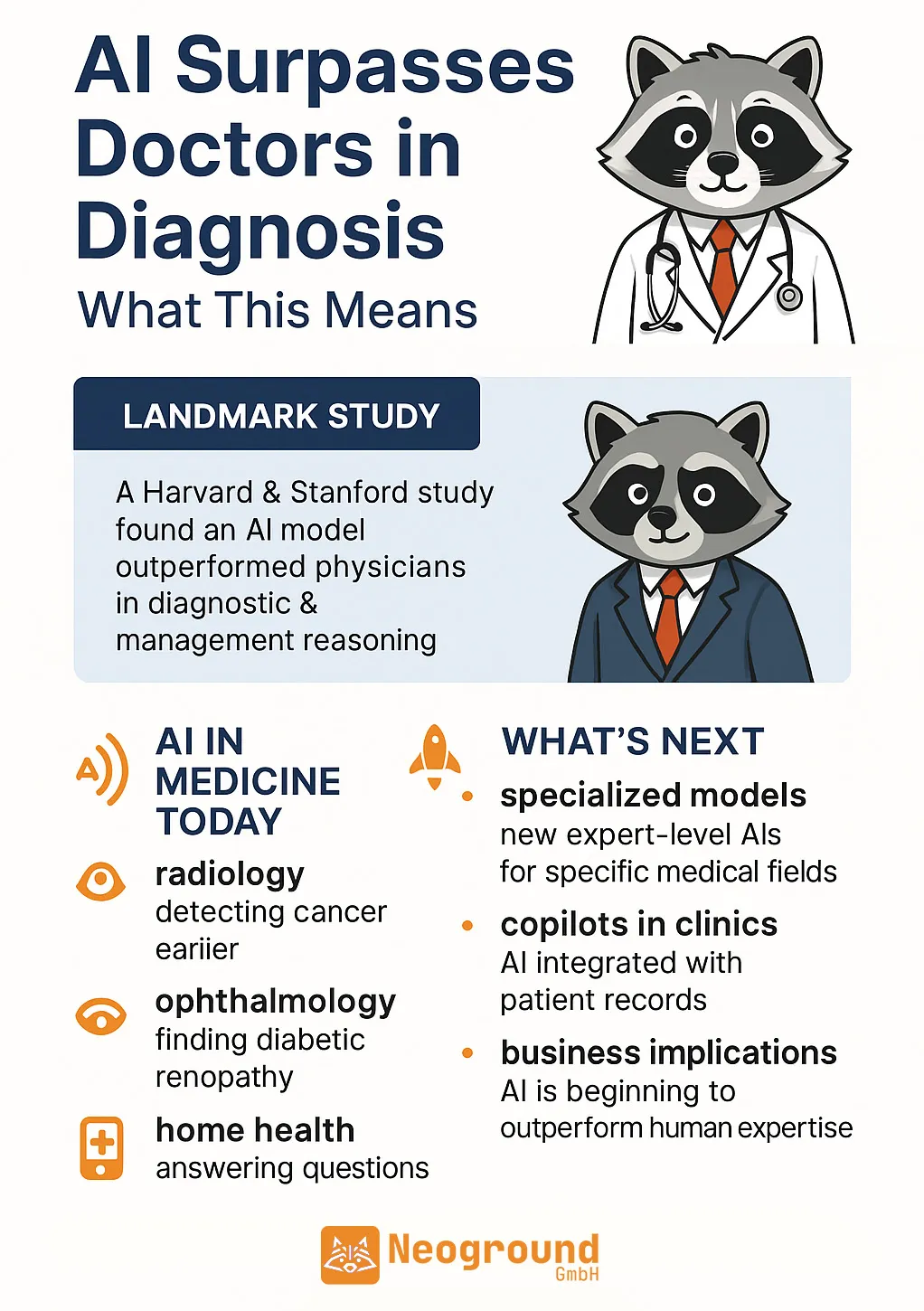The Moment We’ve Crossed
In 1959, the scientists Ledley and Lusted imagined computers that might one day match a physician’s diagnostic skill. Sixty-six years later, a multi-institution team from Harvard, Stanford and Cambridge Health Alliance has delivered the answer: a large-language model (“o1-preview”, nowadays, a few months later, already dated and replaced by the even more capable o3 model) not only matched doctors—it beat them outright in complex diagnostic and management reasoning tasks. Read the study here: Arxiv: 2412.10849 Superhuman performance of a large language model
On live emergency-department cases the model scored higher than board-certified physicians at three critical touch-points: triage, initial evaluation and inpatient admission. The researchers call the result “super-human performance.” No hype—just peer-reviewed data.
How the Study Worked (and Why It Matters)
- Five independent experiments measured skills that define real-world clinical reasoning—generating differentials, weighing probabilities, planning management.
- Scores were compared against hundreds of practising doctors, with blinded expert adjudication.
- The LLM’s edge was most dramatic in management planning, traditionally the messiest human task. Doctors aided by reference materials or even GPT-4 could not close the gap.
If an off-the-shelf, general model can reason better than domain experts in one of the most knowledge-dense professions on earth, we have crossed a threshold: reasoning itself has become scalable.
AI in the Clinic Today
The Harvard results are only the most eye-catching data point on a wider curve:
- Radiology. A nationwide Swedish trial found AI-supported double reading detected more breast cancers than two radiologists working together, without raising recall rates.
- Ophthalmology. EyeArt became the first FDA-cleared autonomous system to spot diabetic retinopathy straight from a retinal photo—no clinician required.
- Dermatology. A 2024 Nature meta-analysis shows AI classifiers achieving sensitivity and specificity on par with specialist dermatologists across thousands of skin-lesion images.
- Medical Exams. GPT-4 and GPT-4o already post over 90 % accuracy on USMLE-style questions, far above the average medical student and in some domains rivaling certified practitioners.
- Regulatory Momentum. The US FDA has now cleared more than 600 AI-powered devices, with radiology and cardiology leading the charge.
In short: from images to text, bedside to back-office, the stack of clinical tasks where AI equals or exceeds human baseline performance is expanding every quarter.
My Own Micro-Example
Some months ago I developed a small dermatitis. Just some red spot that didn't want to heal. Instead of a same-week appointment, I gave GPT-4o the description, a photo and that I want to work with OTC medication only. It recommended a few possible causes (e.g. this could be fungal, so it recommended a mild anti-fungal cream). After some refinement and further descriptions of the skin and its behavior, we decided on a pure moisture-barrier protocol with some simple skin healing cream. A few follow ups over the weeks confirmed our theories and that it's working, like the skin becoming smoother, more yellow-ish, less red. Four weeks later—problem solved, no prescription, no waiting room. A trivial case, yes, but a lived demonstration of how consumer-tier models already shift care burdens away from clinics.
The “Million-Case” Advantage
Veteran clinicians draw on maybe 10–20 000 patient encounters across a career. A contemporary medical LLM has effectively “read” millions of cases, including the zebras many doctors never meet. It is less a freshly minted resident than a retired professor with perfect recall—only faster, cheaper and permanently on call.
Where We’re Headed (2025-2030)
- Fine-tuned Specialist Models. Expect oncology-specific agents trained on multiplex omics, or cardiology copilots that ingest live telemetry.
- Tight EHR Integration. Models that pull labs, meds, allergies and local guidelines in real time will close the loop between recommendation and action.
- Global Triage Networks. Rural clinics and emerging-market health posts will deploy cloud LLMs as first-line diagnosticians, flattening access disparities.
- Regulation & Liability. Europe’s AI Act and the FDA’s device pathways will harden, requiring transparent audit trails and shared doctor/algorithm accountability.
- Human Role Shift. Clinicians pivot towards empathy, complex procedural skill, ethics and oversight—everything the algorithm can’t yet embody.
- Personalized Treatments. Get medication which is optimized and crafted for your body for best effects. Or also finding a better dose. Not taking 20mg every 24 hours but 16,9mg every 18 hours for maximum effect.
Spill-Over to Other Industries
If AI can outperform a physician—the archetype of expert reasoning—no function anchored merely in pattern recognition or probabilistic judgement is safe from disruption:
- Logistics route optimization
- Financial anomaly detection
- Legal triage and document synthesis
- Manufacturing quality control
The same capability curve that just cleared the medical bar is pointed next at boardrooms and back-offices everywhere. Just like computers and the internet are now part of most professions, so will AI. Helping us to reach more, do more with less, and relieve many domains which are currently at their limits.
A Pragmatic Call for Businesses
Staying passive until “AI is perfect” is no longer an option. Early adopters will:
- Audit workflows for high-cognitive-load, rules-bound tasks
- Pilot domain-specific LLM agents under controlled governance
- Upskill staff to supervise, not compete with, algorithmic partners
- Be proficient in working with modern AI, long before others will catch up
AI might not be perfect yet, but it's clear where we're heading. Just like in the days of 56k internet or the uprise of GUI based computers in the early 90s.
Final Thoughts — and How Neoground Can Help
We stand at the first inflection where industrialized reasoning becomes a cloud utility. Medicine offers the proof; the rest of the economy is the addressable market.
At Neoground, we help organizations navigate this shift—identifying high-impact use cases, integrating secure LLM pipelines, and architecting the human-in-the-loop processes that keep innovation safe and ethical.
Curious what “AI-superhuman” could mean for your sector?
Oh and as always—here's our summary as an infographic:

This article was created by us with the support of Artificial Intelligence (GPT-o3).
All images are AI-generated by us using Sora.




Noch keine Kommentare
Kommentar hinzufügen